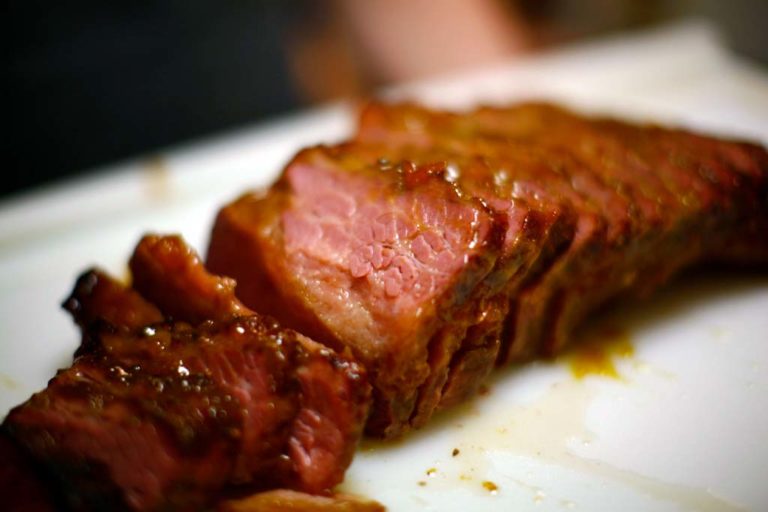
Chef's notes:
In America, St. Patrick’s Day means parades, drinking, dancing, bagpipes, corned beef, and lots of green. Of course, how we celebrate St. Pat’s is a bit different than how it’s done in Ireland. For example, corned beef is not commonly found on the menu in Ireland. From what I understand, lamb stew is more traditional. But corned beef has become a part of the American way of celebrating the holiday. It has become a tradition. Albeit a a fairly recent tradition, but a tradition nonetheless.
Corned beef, despite the name, does not actually contain any corn. It is beef brisket that has been brined with spices. The word corn refers to the kernels of salt used in the brine. There are two main methods of preparing corned beef: boiled and roasted. I have used both preparations, and the following is the best method I have found.
Ingredients
- 4 lbs corned beef brisket
- 1 cup apricot jam
- 1 tsp ground clove
- 1 tsp dry mustard
- 1/2 tsp ground cinnamon
Roast Corned Beef Brisket Recipe: Glazed with Apricot Jam mixed with Spices
- Preheat the oven while you prep the corned beef. Preheat the oven to 450 degrees F and move the racks so there is enough room for the roasting pan with the beef in it. Next, take the corned beef out of the package and place it on the rack in the roasting pan. The extra juices are not necessary, so let them run down the drain. It is blood and brine, which your corned beef has plenty of. The corned beef has already been heavily flavored through the brining process, so you won’t need to add any spices to it at this point. Put 2–3 inches of water into the bottom of the pan. Once the oven has reached 500 degrees F, turn it down to 375 and put the corned beef in.
- Put the corned beef into the oven with a digital thermometer in the middle. Using a digital thermometer with a detachable probe is going to be your best bet for hitting the right temperature. The tip of the probe is where the reading is taken, so make sure that the very tip is in the very middle of the beef. The temperature you are looking for is 125 degrees F. I used a 4 pound brisket, and it took just over 2 hours to cook to 125 in a 375 degree oven. Check it after an hour, and you may need to add more water.
- After the internal temp of the corned beef is 125 degrees F, take it out of the oven. This step is an extra option for people who like glazes on their corned beef. If you are a purist and would prefer to cook it with no glaze, just continue step 2 until the corned beef reaches an internal temperature of 150 degrees F. For the glaze I used 1 C apricot jelly, 1 tsp dry mustard, 1 tsp ground cloves, and ½ tsp cinnamon. The trick with this wet glaze is to put it on in two applications. This way less will melt off and fall into the bottom of the pan. Put the glazed corned beef back into the oven and cook for another 15 minutes. Then take it out and reapply the glaze.
- Once you have applied the second coat of glaze, cook it in the oven until it reaches an internal temperature of 150 degrees F. The USDA recommends an internal temp of 160. I think a temp of 150 is more than adequate for corned beef. Take it out of the oven, and let it rest 20–30 minutes before you cut into it. When you do cut the corned beef, make sure to cut the slices thinly and to cut against the grain. There are two things commonly served with corned beef: mustard and horseradish.
Tips & Tricks
- The New England Boiled Dinner is something much different than what I have described above. It is corned beef boiled in a pot of water. Once the beef is almost done, you add the potatoes, carrots, and cabbage. This is what many people are used to eating on St. Patrick’s Day, but it is a New England tradition and not an Irish one.
- If you are making corned beef for sandwiches, the thinner the slice, the easier it will be to eat on a sandwich.
- Make sure to purchase raw, uncooked corned beef for this recipe. The precooked stuff is intended for sandwiches.
- Corned beef is available in flat pieces and in smaller rounded pieces. The flat pieces are easier to slice and eat since the grain is easy to follow. The round pieces are usually cheaper because not as many people want them. Either way, corned beef usually goes on sale after St. Patrick’s Day. So stock up!
